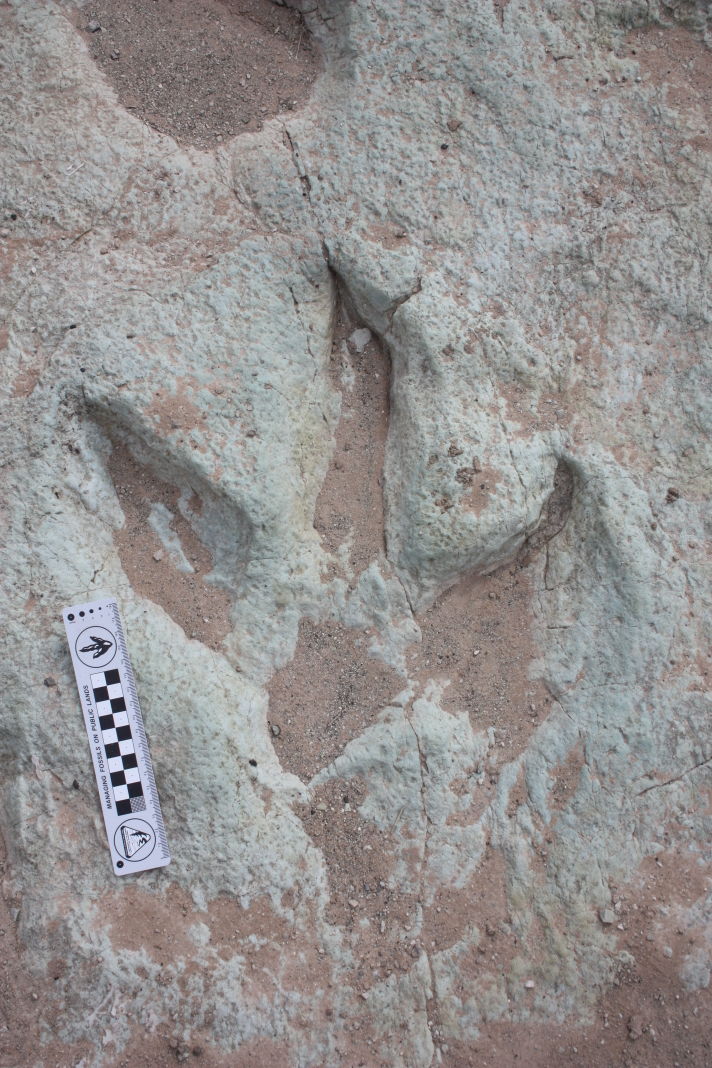Some information may be outdated.
Paleontologists from the University of Colorado and the Bureau of Land Management (BLM) have been excavating a location north of Moab for the past year. The site contains over 200 tracks left by dinosaurs over a 125 million years ago.
“(This is) one of the best track sites in the region,” paleontologist and Museum of Moab director John Foster said.
The tracks were first discovered in 2009 by Moab resident John Cowan. While out hiking after a heavy rain, he noticed a print in the road that had been uncovered where the rain had run through a dry wash. Scientists and paleontologists have been actively studying and documenting the site ever since.
“The tracks have been preserved this entire time,” BLM Canyon Country District Paleontologist Rebecca Hunt-Foster said. “The research is ongoing and we are learning many new things from this site that are helping to advance the science of paleontology and the study of tracks, along with managing the site using scientific principles and expertise.”
While the site has been studied and preserved for the past few years, the actual excavation of the area has occurred during the past year.
“With an excavation permit issued by the BLM, the researchers have removed the overlying soil using shovels and brooms, and were approved to use a skid loader with soft rubber tracks to remove bulk overlying overburden, that was over a foot above the actual track surface,” Hunt-Foster said.
Lee Shenton, the current president of the Gastonia Chapter (Moab) of Utah Friends of Paleontology and a volunteer with the project, said the excavation process has been “lots of work.”
“When you get closer to the tracks you need to remove the (soil) by hand-shoveling and finally some careful detail work, perhaps with screwdrivers or trowels,” Shenton said. “The last couple of inches of soil can be hard, and we are being careful to avoid damaging the tracks, which are in hard, but brittle, rock.”
Shenton said the paleontologists and volunteers have exposed about 20 percent of the area they are working on.
The tracks have been identified as belonging to the Early Cretaceous Cedar Mountain Formation. The Cedar Mountain Formation is a layer of sedimentary rock found in eastern Utah. Researchers determine the age of the tracks by studying the surrounding rock units.
“Researchers with the Utah Geological Survey have correlated, or matched up, the unit to another outcrop to the east, and were able to obtain a zircon date of about 112 million years in age,” Hunt-Foster said.
Researchers have identified 10 different types of tracks at the site. Hunt-Foster said there are multiple animals represented, including three different types of theropods, sauropods, ornithopods, dromaeosaurs, ankylosaurs, crocodiles, and birds. Other species may be present at the site, but not much is known about these species because there are not many fossils available to learn from.
“The discovery helps us understand what animals are present during this period of time in the Early Cretaceous period, where body fossils are not well known. It also helps us to compare this track site to other track sites known from the same age elsewhere in the world, such as China and Korea,” she said.
After researchers have finished uncovering the tracks, the BLM plans to start construction on an interpretation trail for the area, which will include signage with information about the tracks. Funds for the trail are being raised by Utah Friends of Paleontology and Canyonlands Natural History Association. BLM officials are aiming for sometime during the upcoming fall season to open the interpretive trail for the general public. The specific location has not yet been made public.
“Visitors will be able to see the first dromaeosaur tracks in North America, and also learn about how these dinosaurs walked, how fast they were going, how big they are, what the environment was like, how tracks are made and preserved, and why track sites like these are important to preserve and protect,” Hunt-Foster said.
The site will also remind visitors to the area to respect and protect paleontological resources.
“It is against federal law to damage or remove tracks, which includes casting and molding of tracks, and requires a permit,” Hunt-Foster said. “We ask that if anyone see any damage or vandalism that they contact the BLM or other local law enforcement.”
“Researchers with the Utah Geological Survey have correlated, or matched up, the unit to another outcrop to the east, and were able to obtain a zircon date of about 112 million years in age.”
Tracks discovered north of Moab by local resident
Appreciate the coverage? Help keep local news alive.
Chip in to support the Moab Sun News.





